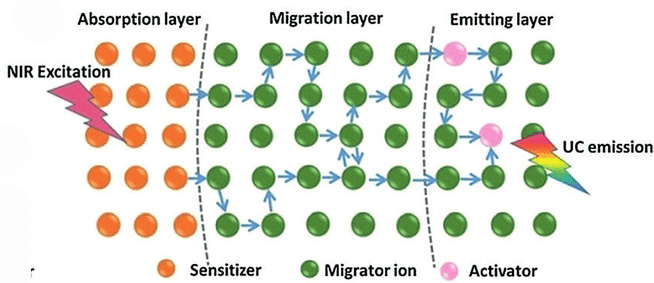| Posted: Jan 31, 2018 |
Precisely tailoring the dynamics of upconversion luminescence in nanoparticles
(Nanowerk News) A team of researchers led by Professors Hong Zhang (photonic nanochemistry) and Evert Jan Meijer (computational chemistry) of the University of Amsterdam's Van 't Hoff Institute for Molecular Sciences has significantly improved the fundamental understanding of photon upconversion in nanoparticles. Through the collaborative approach of advanced spectroscopy and theoretical modelling they were able to establish that the migration of excitation energy greatly affects the upconversion dynamics.
|
|
In a recent publication in Angewandte Chemie ("Precisely Tailoring Upconversion Dynamics via Energy Migration in Core-Shell Nanostructures") the researchers describe how 'dopant ions spatially separated' (DISS) nanostructures can be used for tailoring the upconversion dynamics.
|
 |
| The upconversion process in the 'dopant ions spatial separated' nanostructure. Here, the three basic processes of photon absorption, energy migration, and UC emission, are spatially separated. (Image: HIMS)
|
|
Upconversion is a process in which one photon is emitted upon absorption of several photons of lower energy. It thus 'jacks' the light from lower to higher frequencies. Typically upconversion materials are doped with lanthanide ions. These are able to shift the near infrared (NIR) light of an economic continuous wave milliwatt laser towards higher, visible frequencies and even into the ultraviolet (UV) spectral region. Potential applications in super resolution spectroscopy, high density data storage, anti-counterfeiting and biological imaging and photo-induced therapy.
|
|
Upconversion luminescence dynamics has long been believed to be determined solely by the emitting ions and their interactions with neighbouring sensitizing ions. The current research shows that this does not hold for nanostructures. Zhang, Meijer and co-workers demonstrate that in nanocrystals the luminescence time behaviour is seriously affected by the migration process of the excitation energy.
|
|
The research was performed in a cooperation between the HIMS groups of professors Hong Zhang (photonic nanochemistry) and Evert Jan Meijer (computational chemistry), and the group of professors Xianggui Kong and Hong Zhang at Changchun Institute of Optics, Fine Mechanics and Physics (CIOMP), Chinese Academy of Sciences (CAS).
|
|
The researchers unravelled the intimate link between the random nature of the energy migration and the upconversion luminescence time behaviour by means of a complementary approach of advanced spectroscopy and time-resolved Monte Carlo simulation. As model systems they used so-called 'dopant ions spatially separated' (DISS) nanostructures, where activators and sensitizers are located into different spatial regions of a single nanoparticle. The influence of energy migration could be quantitatively depicted by tuning the thickness of the migration layer or by varying the migrator ion dopant concentration in the migration layer.
|
|
It was thus established that, as a result of its random nature, the migration of the excitation energy between any two points in the crystal takes more time than what would be expected from a straight point-to-point energy transfer.
|
|
Based on this new fundamental insight, the researchers were able to successfully control the upconversion luminescence time behaviour (either the rise or decay process) by tuning the energy migration paths in various specifically designed DISS nanostructures. This result is significant for the application of this sort of materials in super resolution spectroscopy, high density data storage, anti-counterfeiting and biological imaging.
|

